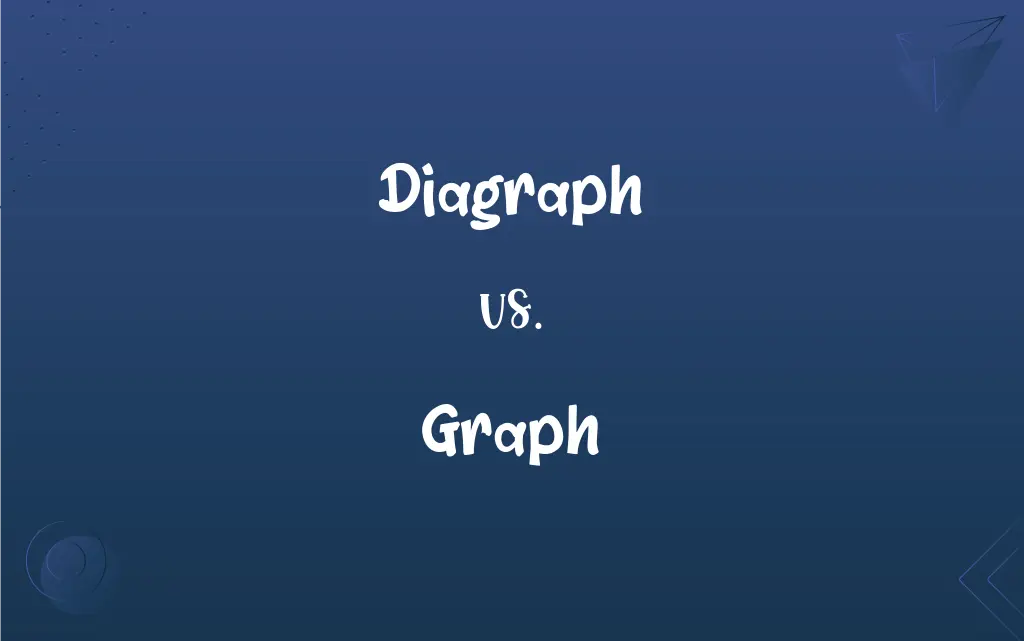Diagraph vs. Graph: What's the Difference?
By Harlon Moss & Janet White || Updated on May 23, 2024
A digraph is a directed graph where edges have a direction, whereas a graph (undirected) consists of vertices connected by edges without any direction.

Key Differences
A digraph, or directed graph, consists of vertices connected by directed edges. Each edge has a direction, indicating a one-way relationship between two vertices. Digraphs are commonly used to represent systems where direction matters, such as web page links or road maps with one-way streets. A graph, in contrast, is undirected, meaning its edges do not have a direction. The connection between vertices in a graph is bidirectional, indicating a mutual relationship. Graphs are used to model systems where connections are inherently reciprocal, like social networks or undirected road maps.
In a digraph, the concept of in-degree and out-degree is crucial. In-degree refers to the number of edges coming into a vertex, while out-degree refers to the number of edges going out from a vertex. This distinction is not present in an undirected graph, where each edge contributes equally to the degree of both connected vertices.
The representation of paths in digraphs involves the sequence of directed edges, considering the direction of each edge. In undirected graphs, paths are simpler as the direction is irrelevant, focusing only on the connections between vertices.
Digraphs are often used in computer science for tasks like representing finite state machines, where states and transitions are directional. Undirected graphs are used in problems like finding the shortest path in a network where the connections are bidirectional.
Digraph algorithms, such as those for finding the shortest path (e.g., Dijkstra's algorithm with modifications for direction), differ from those for undirected graphs due to the directional constraints. Undirected graph algorithms are generally simpler since they don't need to consider edge direction.
ADVERTISEMENT
Comparison Chart
Edge Direction
Directed edges
Undirected edges
Vertex Degrees
In-degree and out-degree
Single degree count
Path Representation
Sequence of directed edges
Sequence of edges
Common Uses
Web links, finite state machines
Social networks, undirected maps
Algorithm Complexity
More complex due to directions
Simpler, no direction consideration
ADVERTISEMENT
Diagraph and Graph Definitions
Diagraph
Edges have direction.
In a digraph, the edge from A to B is different from B to A.
Graph
Representing mutual relationships.
The graph models undirected social connections.
Diagraph
Representing one-way relationships.
The digraph model shows one-way street systems.
Graph
A graph with undirected edges.
The graph represents a network of friends.
Diagraph
A graph with directed edges.
The web's hyperlink structure forms a digraph.
Graph
Single degree count per vertex.
Each vertex in the graph has a degree based on connected edges.
Diagraph
In-degree and out-degree relevance.
The digraph shows vertex in-degrees and out-degrees.
Graph
Used in simpler connectivity problems.
Finding the shortest path in a city map uses an undirected graph.
Diagraph
Common in computer science.
Finite state machines are often modeled using digraphs.
Graph
A diagram that exhibits a relationship, often functional, between two sets of numbers as a set of points having coordinates determined by the relationship. Also called plot.
Diagraph
(dated) A drawing instrument that combines a protractor and scale.
Graph
A pictorial device, such as a pie chart or bar graph, used to illustrate quantitative relationships. Also called chart.
Diagraph
A drawing instrument, combining a protractor and scale.
Graph
The spelling of a word.
Graph
Any of the possible forms of a grapheme.
Graph
A written character that represents a vowel, consonant, syllable, word, or other expression and that cannot be further analyzed.
Graph
To represent by a graph.
Graph
To plot (a function) on a graph.
Graph
A data chart (graphical representation of data) intended to illustrate the relationship between a set (or sets) of numbers (quantities, measurements or indicative numbers) and a reference set, whose elements are indexed to those of the former set(s) and may or may not be numbers.
Graph
(mathematics) A set of points constituting a graphical representation of a real function; (formally) a set of tuples , where for a given function . See also Graph of a function Category:en:Curves Category:en:Functions
Graph
(graph theory) A set of vertices (or nodes) connected together by edges; (formally) an ordered pair of sets , where the elements of are called vertices or nodes and is a set of pairs (called edges) of elements of . See also Graph (discrete mathematics)
Graph
(topology) A topological space which represents some graph (ordered pair of sets) and which is constructed by representing the vertices as points and the edges as copies of the real interval [0,1] (where, for any given edge, 0 and 1 are identified with the points representing the two vertices) and equipping the result with a particular topology called the graph topology.
Graph
A morphism from the domain of to the product of the domain and codomain of , such that the first projection applied to equals the identity of the domain, and the second projection applied to is equal to .
Graph
A graphical unit on the token-level, the abstracted fundamental shape of a character or letter as distinct from its ductus (realization in a particular typeface or handwriting on the instance-level) and as distinct by a grapheme on the type-level by not fundamentally distinguishing meaning.
Graph
(transitive) To draw a graph.
Graph
To draw a graph of a function.
Graph
A curve or surface, the locus of a point whose coördinates are the variables in the equation of the locus; as, a graph of the exponential function.
Graph
A diagram symbolizing a system of interrelations of variable quantities using points represented by spots, or by lines to represent the relations of continuous variables. More than one set of interrelations may be presented on one graph, in which case the spots or lines are typically distinguishable from each other, as by color, shape, thickness, continuity, etc. A diagram in which relationships between variables are represented by other visual means is sometimes called a graph, as in a bar graph, but may also be called a chart.
Graph
A drawing illustrating the relations between certain quantities plotted with reference to a set of axes
Graph
Represent by means of a graph;
Chart the data
Graph
Plot upon a graph
Graph
Edges are bidirectional.
In a graph, an edge between A and B implies a mutual connection.
FAQs
What is a graph?
A graph is a structure with undirected edges, showing mutual connections.
What is in-degree in a digraph?
In-degree is the number of edges coming into a vertex in a digraph.
What are common uses of graphs?
Graphs are used in social networks, undirected road maps, and connectivity problems.
How do paths differ in digraphs and graphs?
Paths in digraphs consider edge direction, while in graphs, they do not.
What is out-degree in a digraph?
Out-degree is the number of edges going out from a vertex in a digraph.
How do edges differ in digraphs and graphs?
In digraphs, edges have direction; in graphs, edges are bidirectional.
What is a digraph?
A digraph is a graph with directed edges, indicating one-way relationships.
Do undirected graphs have in-degrees and out-degrees?
No, undirected graphs have a single degree count per vertex.
Do digraphs have cycles?
Yes, digraphs can have cycles, where paths return to the starting vertex following edge direction.
What are common uses of digraphs?
Digraphs are used in web page linking, one-way street maps, and state machines.
What is a real-world example of a digraph?
A web hyperlink structure, where links point from one page to another.
What fields use digraphs extensively?
Computer science and network theory extensively use digraphs.
Can a graph be converted to a digraph?
Yes, by assigning directions to its edges.
Can a digraph be converted to a graph?
Yes, by removing the direction from its edges.
What fields use graphs extensively?
Mathematics, computer science, and social sciences use graphs.
Do digraphs and graphs share common properties?
Yes, both consist of vertices and edges, and can represent complex networks.
Do graphs have cycles?
Yes, graphs can also have cycles, with paths returning to the starting vertex.
Is degree calculation different in digraphs and graphs?
Yes, digraphs have separate in-degrees and out-degrees, while graphs have a single degree count.
Are algorithms for digraphs more complex?
Yes, because they must account for edge direction.
What is a real-world example of a graph?
A social network, where connections represent mutual friendships.
About Author
Written by
Harlon MossHarlon is a seasoned quality moderator and accomplished content writer for Difference Wiki. An alumnus of the prestigious University of California, he earned his degree in Computer Science. Leveraging his academic background, Harlon brings a meticulous and informed perspective to his work, ensuring content accuracy and excellence.
Co-written by
Janet WhiteJanet White has been an esteemed writer and blogger for Difference Wiki. Holding a Master's degree in Science and Medical Journalism from the prestigious Boston University, she has consistently demonstrated her expertise and passion for her field. When she's not immersed in her work, Janet relishes her time exercising, delving into a good book, and cherishing moments with friends and family.
































































